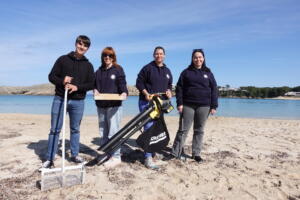New data on plastic pollution on Menorca’s beaches
Our Plastic Free Menorca Alliance analyses more than 7,800 pieces of plastic waste present on Menorca’s coastline to understand and raise awareness of plastic pollution on the island

The Plastic Free Menorca Alliance is making progress in understanding and raising awareness of plastic pollution on the island with field trips and activities to characterise the plastic waste present on the coast
The Plastic Free Menorca Alliance, promoted by Menorca Preservation with the support of other environmental organisations, has analysed a total of 7,804 plastic waste items present on the island’s coastline, successfully completing its project ‘Characterisation and awareness-raising of plastic pollution on Menorca’s beaches’. This initiative, which has received the support of the Ministry of Agriculture, Fisheries and Natural Environment of the Balearic Islands Government, arose with the aim of raising awareness, visualising and analysing the plastic pollution present on the island’s coastline, through the organisation of waste collections with educational centres, social entities and the local population.
A project with environmental and social impact
The initiative was developed between August and December last year, involving 169 participants through 9 field trips. Schools, associations and the general public collaborated, promoting a culture of environmental awareness and direct action in the fight against plastic pollution. The activities included the collection, classification and analysis of waste on different beaches, enabling the collection of valuable data on the origin and typology of the waste found. In addition, educational sessions for schoolchildren with graphic materials on the impact of waste on marine fauna were also included.
In total, 166.8 kg of plastic waste (7,804 units) were collected and analysed, exceeding the initial target of 150 kg. The waste analysed included plastic caps and lids (2,248 units), laminated plastics (1,999 units), polystyrene fragments smaller than 50 cm (770 units), fishing nets and waste (719 units) and lollipop sticks and cotton buds (466 units).
Acquisition of equipment and materials
Thanks to the support received, the project has been able to acquire specific equipment to improve efficiency in the collection and analysis of waste, including: 20 telescopic tweezers to facilitate the collection of waste without direct contact; 1 transport trolley to mobilise the work material; 60 identification waistcoats for the team of volunteers; 2 hoovers for the collection of microplastics; 2 telescopic sieving machines to analyse the composition of the smallest waste; special gloves for children to encourage their participation in a safe environment; reusable baskets for the efficient collection of waste; 2 scales for the accurate measurement of the weight of the waste collected and storage boxes for the organisation and separation of waste collected.
This equipment has made it possible to optimise field trips, making the collection and analysis process more effective and accessible for technicians and participants.
Results and next steps
The data obtained have been incorporated into the database of the Plastic Free Menorca Alliance and will be used to continue with studies on the presence of plastics in Menorca with the aim of designing strategies that contribute to their reduction. At the same time, they have also been shared in collaboration with European projects such as MedPellets by Good Karma Projects and Biomedia by Surfriders, strengthening global knowledge on plastic pollution in the Mediterranean.
During this year, the Plastic Free Menorca Alliance wants to continue increasing its knowledge about this problem, and has created a WhatsApp channel (https://whatsapp.com/channel/0029VazaGRZGehEOFRhEIi0z) to encourage citizens to get involved and participate in these collections.
To this end, it plans to: organise 25 field trips with educational centres, social organisations, the population and companies; create an online map with the data collected; and design and implement a ‘Plastic Observatory’ with a set of indicators and values that will allow us to improve our knowledge of the management, impacts and current regulations in relation to plastic waste.